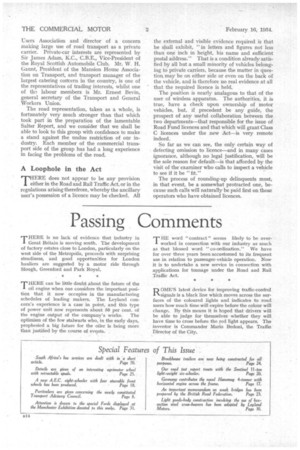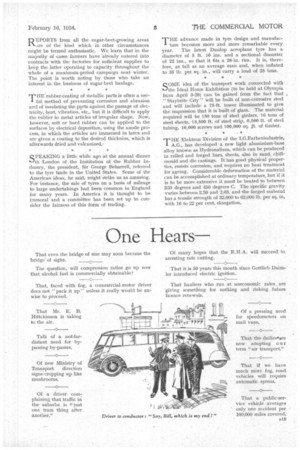Passing Comments
Page 24

Page 25

If you've noticed an error in this article please click here to report it so we can fix it.
rr HERE is no lack of evidence that industry in Great Britain is moving south. The development of factory estates close to London, particularly on the west side of the Metropolis, proceeds with surprising steadiness, and good opportunities for London hauliers are suggested by a motor ride through Slough, Greenford and Park Royal.
THERE can be little doubt about the future of the
1 oil engine when one considers the important position that it now occupies in the manufacturing schedules of leading makers. The Leyland concern's experience is a case in point, and this type of power unit now represents about 50 per cent. of the engine output of the company's works. The optimism of the few stalwarts who, in the early days, prophesied a big future for the oiler is being more than justified by the course of events. . THE word " contract " seems likely to be overworked in connection with our industry as much as that blessed word "co-ordination." We have for over three years been accustomed to its frequent use in relation to passenger-vehicle operation. Now it is to undertake a new service in connection with applications for tonnage under the Road and Rail Traffic Act.
ROME'S latest device for improving traffic-control signals is a black line which moves across the surfaces of the coloured lights and indicates to road users how much time will expire before the colour will change. By this means it is hoped that drivers will be able to judge for themselves whether they will have time to cross before the red light appears. The inventor is Commander Mario I3edoni, the Traffic Director of the City. REPORTS from all the sugar-beet-growing areas are of the kind which in other circumstances might be termed enthusiastic. We learn that in the majority of cases farmers have already entered into contracts with the factories for suffiCient supplies to keep the latter operating to capacity throughout the whole of a maximum-period campaign next winter. The point is worth noting by those who take an interest in the business of sugar-beet haulage.
HE rubber-coating of metallic parts is often a use ful method of preventing corrosion and abrasion and of insulating the parts against the passage of electricity, heat, vibration, etc., but it is difficult to apply the rubber to metal articles of irregular shape. Now, however, soft or hard rubber can be applied to the surfaces by electrical deposition, using the anode process, in which the articles are immersed in latex and are given a coating to the desired thickness, which is afterwards dried and vulcanized.
SPEAKING a little while ago at the annual dinner P.-1in London of the Institution of the Rubber Industry, the president, Sir George Beharrell, referred to the tyre trade in the United States. Some of the American ideas, he said, might strike us as amusing. For instance, the sale of tyres on a basis of mileage to large undertakings had been common in England for many years. In America it is thought to be immoral and a committee has been set up to consider the fairness of this form of trading. THE advance made in tyre design and manufac
ture becomes more and more remarkable every year. The latest Dunlop aeroplane tyre has a diameter of 5 ft. 10 ins, and a sectional diameter of 22 ins., so that it fits a 26-in. rim. It is, therefore, as tall as an average man and, when inflated to 35 lb. per sq. in., will carry a load of 25 tons.
S0 11/1E idea of the transport work connected with . ■ Jthe Ideal Home Exhibition (to be held at Olympia fr.om April 3-28) can be gained from the fact that " Sta.ybrite City " ivill be built of non-corrosive steel and will include a 75-ft. tower illuminated to give the impression that it is built of glass. The material required will be 150 tons of steel girders, 16 tons of steel sheets, 13,500 ft. of steel strip, 6,500 ft. of steel tubing, 16,000 screws and 100,000 sq. It. of timber.
THE Elektron Division of the I.G.Farbenindustrie, A.G., has developed a new light aluminium-base alloy known as Hydronalium, which can be produced in rolled and forged bars, sheets, also in sand, chillmould and die castings. It has good physical properties, resists corrosion, and requires no heat treatment for ageing. Considerable deformation of the material can be accomplished at ordinary temperature, but if it is to be more extensive it must be heated to between 350 degrees and 450 degrees C. The specific gravity. varies between 2.59 and 2.63, and the forged material has a tensile strength of 32,600 to 62,000 lb. per sq. in, with 16 to 22 per cent. elongation.




















































































